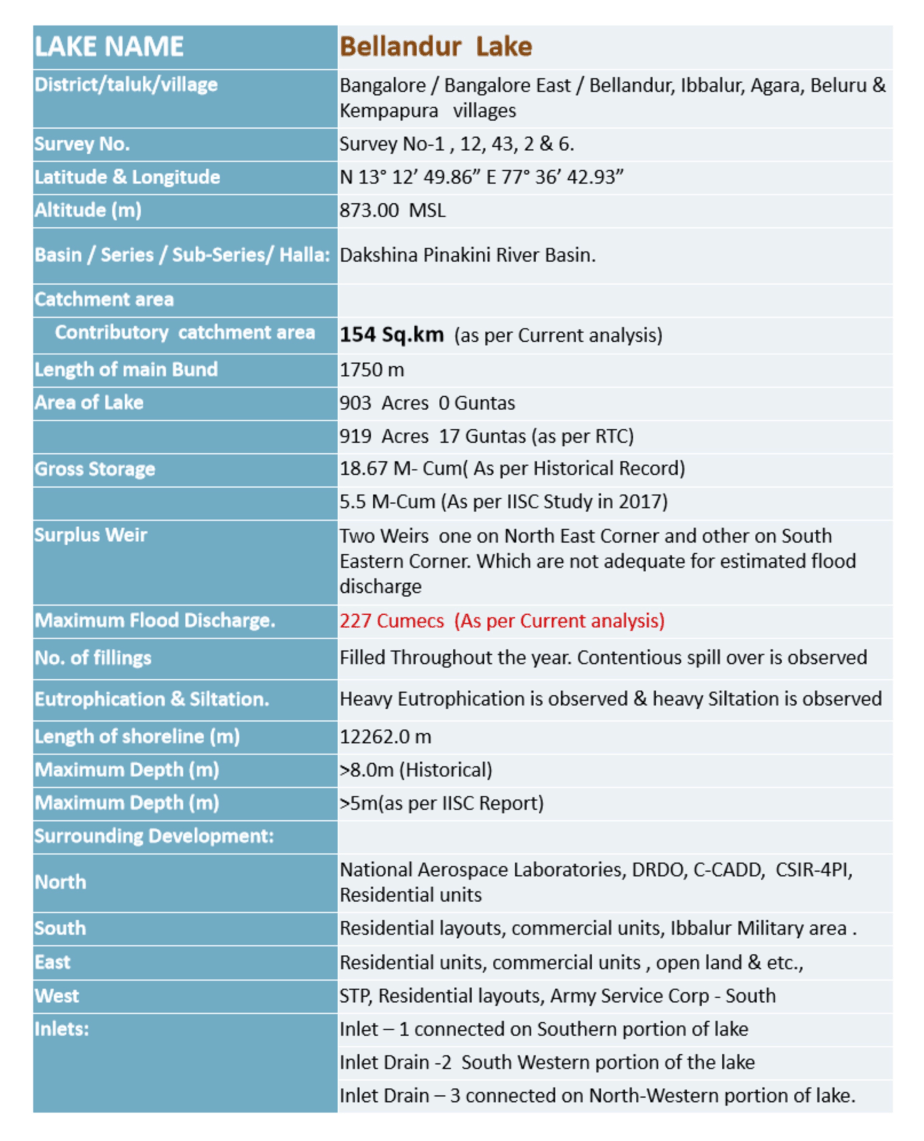Steps to rejuvenate Bellandur lake at a cost of Rs 245 crore could begin soon.
BDA, the custodian of the lake, had floated a tender for the project in January this year. The lowest bidder now awaits approval from the BDA Commissioner to begin work. From the starting date, the contractor will get 18 months to carry out the works.
Besides mammoth works such as de-watering and de-silting of the lake, authorities have revealed plans to also have a children’s play area, an enclosure for immersion of idols during festivals, facilities for water sports, a gymnasium and an amphitheatre.

Page view from BDA’s tender document gives details of Bellandur Lake.
BDA’s plans for the Lake:
- De-watering and de-silting
- Formation of bund adjacent to the main bund
- Formation of walkway bund
- Construction of relieving weir at outlet-1 (44.5m)
- Construction of relieving weir at outlet-2 (32.5m)
- Construction of two entrance gates
- Children’s play area and gym
- A diversion drain
- An amphitheatre
- Creating access to water sports
- Construction of eight gazebos
- Creation of wetland at main inlet
- Creation of wetland at Iblur inlet
- Creation of wetland at HAL inlet
- Landscaping
- Construction of a Kalyani
| It is learnt that while all the plans will be implemented in different phases, major works such as de-watering, de-silting, formation of bunds and construction of diversion drains would be carried out in the first phase itself. According to tender conditions set by the BDA, the work will be taken up involving 10 excavators, four dozers, four vibratory rollers, 50 tippers, six water tankers and manpower in the hundreds.
The tender document lays out clear-cut procedures about how this work should be carried out, as it will be monitored by the Supreme Court’s National Green Tribunal:
|
Mahadeva Gowda, BDA’s Executive Engineer (East zone) says, “The bidder has been finalised and the same has been sent for the approval of the commissioner. The approval may come any time. Soon after, the work order will be issued to the contractors. Work could begin in a month.”
Revealing plans for a gym, amphitheatre and a kalyani (stepped tank), Gowda said, “The public have been immersing Ganesha idols (directly) in the lake. Construction of a Kalyani will prevent it. However, the restoration works will come up in the first phase and other works will be taken up in further phases.”
The BDA’s approach to restoration has, however, disappointed many, including those who were part of the expert committee that made recommendations on reviving the lake. In fact, the committee had clearly said that work such as de-silting and de-watering should be taken up only after diversion of sewage inflow and construction of sewage treatment plants.
Mahendra Jain, former Additional Chief Secretary of the Urban Development Department who headed the expert committee, says, “We had suggested that the desilting and dewatering will have to be taken up at some point in time, but only after stopping untreated effluent flowing into the lake. Otherwise untreated sewage will come into the lake and yet again contaminate it,” he said.
Jain said there are two approaches to going about it: “Either you treat that (sewage) or (if) you want to do it early and you don’t want to wait till your STPs are ready and if the quantum of untreated sewage is less, then you can divert it. But you cannot allow the untreated sewage flow into the lake. While diverting there has to be some bio-remediation by growing some plants, as can be seen in Sarjapura, Agara and other lakes, so that even the small amount of untreated sewage can be settled through oxygenation and other remedies. The development works should be taken up only after taking these remedies and after the development works, the sewage cannot be allowed in because the entire effort will go in vain.”
The list of works in the tender has not found favour with many citizen activists either. One of them, Suresh N R believes that it is “purely a contractor-oriented” work rather than a citizen-oriented one. “This is no way connected to improving the ecology of the lake. This work is not for birds, citizens or what the lake wants. This is planned to help officials, contractors and politicians. Unfortunately this happens irrespective of who governs our city. I strongly oppose this,” he says.
He believes that instead of “wasting money on beautification and unwanted works”, it can be better invested on Varthur lake or other lakes where money is required.
Speaking to Citizen Matters, Diana Emanuel, Member of Bellandur Kere Team said, “Firstly the de-silting needs to be taken up to remove the contaminants that have accumulated over the past 50 years. The power of modern technology and approach has been seen in many lakes but somehow I don’t see the will here. The will to complete the work and will to spend funds in the right direction does not seem to be there in this case,” she said.
[Addendum: The quote by Diana Emanuel has been edited for clarity]
But none of the above steps include curbing of pollution dumped into the lake which causes all that foaming. 🙁
Better late than never.Abegining appears to have been made and it may take 18-24 months by then the mega STP is expected to be ready.This project needs well coordinated monitoring to complete it in time.
What is missing in the report are the illegal encroachments,their removal,comprehensive fencing the lake boundary.These are important for holistic rejuvenation.